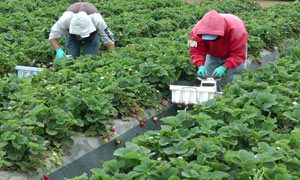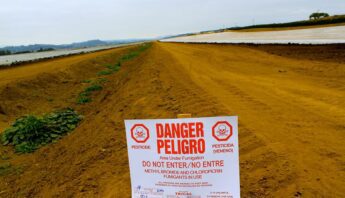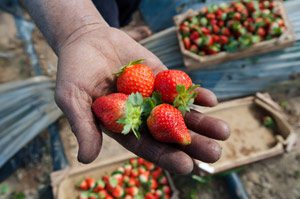Contacts:
Paul Towers, Pesticide Action Network
ptowers@panna.org, 916-216-1082
Tracey Brieger, Californians for Pesticide Reform
tracey@pesticidereform.org, 415-215-5473
April 9, 2013
State Releases Plan for Safe Strawberry Fields
Farmers & scientists call on state to identify clear steps to support growers
and phase out fumigants by 2020
SACRAMENTO, CA — More than a year after manufacturer Arysta LifeScience agreed to remove cancer-causing methyl iodide from the market, state officials released a report today detailing current research to help strawberry growers transition off other fumigant pesticides still widely used in agricultural operations.
Farmers, scientists and health advocates welcomed the report, but stressed that swifter and bolder steps are necessary to ensure that California agriculture remains innovative and prosperous into the future. In policy recommendations released today, these groups are urging the state to adopt a clear timeline and allocate necessary resources to transition all California crops — not just strawberries — off of fumigants by 2020.
“California farmers are ready, willing and able to lead the nation in transitioning off of fumigant pesticides. We need to do this for the sake of our soil, to protect neighboring communities and to ensure a resilient and sustainable farm economy into the future. But we need the right tools for the job, and we won’t have those tools unless the state invests in safe soil management technologies and techniques to replace fumigants,” said Dan Gannon, owner of Humble Roots CSA in West Sacramento.
All fumigants are under increasing scrutiny. Methyl bromide, a widely used fumigant, was banned in 2005 and has remained on the market over a decade, now slated for phase-out by 2015 under an international treaty agreement. Restrictions on the use of other fumigants have increased as more data become available on serious health impacts resulting from exposure. Fumigants also reduce farmers’ long-term ability to manage pests because they “sterilize” the soil, killing the live soil organic matter that forms the basis of naturally resilient farming systems.
A panel of experts, convened for over six months by the California Department of Pesticide Regulation (DPR), released a “Nonfumigant Action Plan” today focusing on transitioning the state’s strawberry farmers off of fumigants. The panel — whose membership includes academic specialists in economics and agricultural production, farmworker safety specialists and business leaders — reviewed replacement techniques for soil fumigant pesticides, as well as the economic and production-level barriers to farming without fumigants. The report focuses on strawberry production, though the new techniques would also be relevant for other crops that rely on fumigants.
The body of DPR’s 40-page report provides a thorough and promising review of the most cutting-edge fumigant replacement technologies and practices, and next research steps to make them market ready. By contrast, the report’s Executive Summary misses the mark by advocating for continued methyl bromide use with no end in sight.
“Continuing to rely on fumigants such as methyl bromide is hitting the snooze alarm on innovation and putting the continued prosperity of California agriculture at risk. California officials need to plot a clear path forward to adopt safe fumigant replacements by 2020 if they want to ensure that the state’s agricultural economy continues to thrive into the future,” said Tracey Brieger, co-director of Californians for Pesticide Reform.
In response to DPR’s report, farmers and scientists welcomed these initial steps while urging the state to take bolder steps to make the transition to fumigant-free farming a reality. In a plan also released today by farm and health advocates, titled “Investing in Innovation: A Policy Roadmap for Resilient, Prosperous Fumigant-Free Farming in California,” the groups urge the state to commit to a clear goal of transitioning California agriculture off of fumigants by 2020, including identifying specific benchmarks, funding sources and which groups will implement the plan. To ensure a successful transition, they recommend that the state provide direct support and expanded agricultural extension services for growers who voluntarily want to transition, fund on-farm field trials of replacement techniques, and expand plant breeding programs to develop disease-resistant varietals for crops that rely on fumigants.
“If the Golden State wants to maintain its place as one of the most productive and prosperous agricultural economies in the nation, we must lead the way in innovative farming practices, starting with healthy soil management. Our universities, scientists and tax dollars must immediately invest in tools and techniques that will allow farmers to grow better crops with fewer chemicals. If we do this, we can have fumigant-free fields in California by 2020,” said Margaret Reeves, PhD, senior scientist at Pesticide Action Network (PAN).
Farmers and entrepreneurs have developed a variety of effective replacements for fumigant pesticides, including use of disease-resistant cultivars, solarization, steam treatments, crop rotations, mustard seed meal and anaerobic soil disinfestation. DPR’s report summarizes the state of the research on such replacements.
“The public and policymakers need to understand that moving away from fumigants is a seismic shift for production agriculture and rural communities. Farmers have always been innovators, but the economic reality is that no individual farmer can keep an operation profitable while inventing a whole new way of farming. To keep California’s agricultural economy productive and competitive, we must move in this direction together and with public support,” said Bob McFarland, President of the California State Grange.
Soil fumigants are applied at very high rates per acre and are readily transformed into a gas, making them difficult to control and prone to drifting away from the application site. They are also some of the most toxic chemicals used in agriculture. Rural families and farmworkers throughout California face the greatest direct threats of exposure from these chemicals, and children are especially vulnerable to the health risks fumigants pose. Last month, through the Californians for Pesticide Reform coalition, the United Farm Workers and PAN submitted more than 15,000 petitions to the California Environmental Protection Agency urging Secretary Matt Rodriguez to chart a path to phase out fumigants in California by 2020.
The “Investing in Innovation” policy roadmap for successful fumigant transition was also released by Californians for Pesticide Reform and the California State Grange today.
# # #
Available for interviews
- Margaret Reeves, PhD, Senior Scientist, Pesticide Action Network and soils specialist
- Bob McFarland, President, California State Grange
- Dan Gannon, farmer & owner of Humble Roots CSA in West Sacramento







